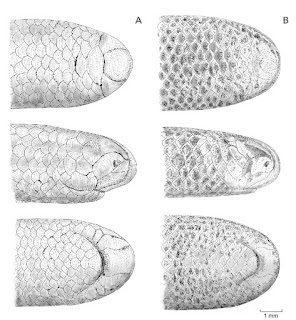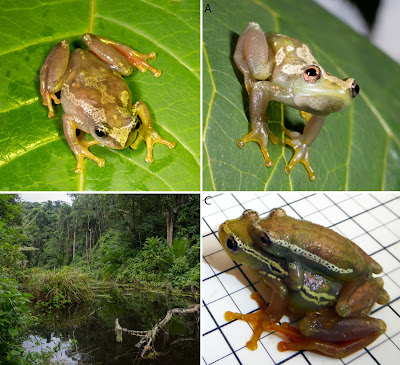[Most Recent Entries] [Calendar View]
Saturday, February 18th, 2023
| Time | Event | ||
| 3:54p | [Herpetology • 2023] More than Meets No Eyes: Taxonomic Status of A Liotyphlops Peters, 1881 (Serpentes: Anomalepididae) Blindsnake from the Atlantic Rainforest
Abstract Liotyphlops Peters, 1881 is an anomalepidid blindsnake genus that encompasses 12 species, widely distributed in Central and South America. In this study, we evaluate the taxonomic status of Liotyphlops sousai Santos & Reis, 2018, a species described based on a single specimen from the Atlantic Rainforest of southern Brazil, and after analyzing evidences based upon molecular systematics, external morphology and osteology, we propose its synonymy with Liotyphlops beui (Amaral, 1924), a common and widely distributed Anomalepidid species. We also provide comments and recommendations on the taxonomy of Liotyphlops, assessing the risks associated with describing a new species based on small type series. Keywords: Atlantic forest, Neotropical, Osteology, Phylogeny, Reptilia, Scolecophidia, Synonymy Omar M. Entiauspe-Neto, Francisco L. Franco, Claudia Koch, Arthur Tiutenko, Juliana M. Wingert and Márcio Borges-Martins. 2023. More than Meets No Eyes: Taxonomic Status of A Liotyphlops Peters, 1881 (Serpentes: Anomalepididae) Blindsnake from the Atlantic Rainforest. Zoologischer Anzeiger. In Press. DOI: 10.1016/j.jcz.2023.01.003 | ||
| 4:17p | [Herpetology • 2023] Hyperolius ukaguruensis • Diversification of Spiny-throated Reed Frogs (Anura: Hyperoliidae) with the Description of A New, Range-restricted Species from the Ukaguru Mountains, Tanzania Abstract The spiny-throated reed frog species group is a small radiation of Hyperolius frogs from East Africa. Unlike many members of the genus which have relatively wide distributions, these species tend to be small-range endemics found in montane and submontane forests. Recent discovery of a golden-hued frog with the clade-specific traits of spines on their gular discs prompted a morphological and genetic exploration of the distinctness of this new lineage and relationships to other members of the clade. Genetic (mitochondrial and nuclear loci) results resolved many sister-relationships, but deeper nodes in the phylogeny were poorly resolved. A reduced-representation genome-wide Single Nucleotide Polymorphism (SNP) dataset was able to fully resolve the phylogenetic relationships within this clade, placing this new lineage, here named after the mountain range in which is it found–Hyperolius ukaguruensis sp. nov., as an early diverging lineage within the group. This new species is distinct from all other spiny-throated reed frogs, necessitating further understanding as a single-mountain endemics vulnerable to habitat loss and potential decline. Morphometric analyses identify clear morphological characteristics that are distinct for the herein described species, most noticeably in that the eyes are significantly smaller than other members of the genus for which we have samples. Hyperolius ukaguruensis sp. nov. Diagnosis.— Horizontal pupil with distinctive gular flap in males. As with most other members of the spiny-throated group (H. spinigularis, H. burgessi, H. davenporti, H. minutissimus, H. ruvuensis, H. ukwiva), H. ukaguruensis sp. nov. also has the presence of dermal asperities (including the body and chin region) on the ventrum. This trait is unique amongst members of the genus Hyperolius. The presence of asperities on the gular flap diagnoses H. ukaguruensis sp. nov. from H. tanneri, for which they are absent. Hyperolius ukaguruensis sp. nov. primarily has asperities anteriorly positioned (closer to the mouth), which differentiates it from H. spinigularis, H. burgessi and H. davenporti which have an even distribution of dermal asperities on the gular flap. Hyperolius minutissimus and H. ukwiva have a similar distribution of asperities to H. ukaguruensis sp. nov.. Furthermore, in males, H. ukaguruensis sp. nov has a distinctively shaped gular flap, differentiating it from H. davenporti, H. tanneri and H. burgessi (Figs 4 & 5). Quantification of differences in gular shape from the H. ukwiva were not possible due to inability to locate the only known male specimen, but should be investigated in future studies. Etymology.— Hyperolius ukaguruensis sp. nov. is named after the forested mountain block (Ukaguru Mountains) where the type series was collected. The species name is a masculine Latin singular adjective in the nominative case. Lucinda P. Lawson, Simon P. Loader, John V. Lyakurwa and H. Christoph Liedtke. 2023. Diversification of Spiny-throated Reed Frogs (Anura: Hyperoliidae) with the Description of A New, Range-restricted Species from the Ukaguru Mountains, Tanzania. PLoS ONE. 18(2): e0277535. DOI: 10.1371/journal.pone.0277535 | ||
| 4:20p | [Arachnida • 2023] Isoxya manangona • Discovery and Genetic Characterization of Single Cohort Adult Colonies With Male Aggregations, and Preliminary Evidence for Lekking in a Malagasy Kite Spider (Araneae: Araneidae: Gasteracanthinae)
Abstract Spiders are notoriously solitary and cannibalistic, with instances of colonial or social lifestyles in only about 50-60, or ~0.1% of 50,000 described species. Population analyses indicate that most colonies consist of multiple cohorts formed by close relatives. Territorial social spiders facultatively form colonies by interlinking individual webs, but further cooperation is infrequent, and only among juveniles or (rarely) females. In spiders therefore, aggregations of males outside of the male-male competition context has been unknown. Here, we report on a discovery of a kite spider from Madagascar that exhibits unique colonies. We found colonies of the newly described araneid Isoxya manangonan. sp. formed by up to 41 interconnected, single-cohort adult female webs with up to 38 adult males aggregating on a central, single, nonsticky line. With males resting tightly together, we found no evidence for male-male aggression. Genetic analyses from RAD sequencing suggest that most colonies consist of unrelated individuals. Furthermore, genetic variability of males was somewhat less than that of females. Single cohort colonies made up purely of adults, and peaceful male aggregations, have not previously been observed in spiders. Although direct behavioral observations are preliminary, we speculate based on the available evidence that these colonies may represent a novel and first case of lekking in spiders. Taxonomy Family Araneidae Clerck, 1757 Genus Isoxya Simon, 1885 Isoxya manangona sp. n. Etymology: The specific epithet is a noun in apposition and refers to the Malagasy verb ‘to gather/aggregate’, referring to the species unusual mating aggregations. Ingi Agnarsson, James Starrett, Zachary Babbitz, Jason E Bond, Matjaž Gregorič, Onjaherizo Christian Raberahona, Steven Williams and Matjaž Kuntner. 2023. Discovery and Genetic Characterization of Single Cohort Adult Colonies With Male Aggregations, and Preliminary Evidence for Lekking in a Malagasy Kite Spider (Isoxya, Gasteracanthinae). Insect Systematics and Diversity. 7(1); DOI: 10.1093/isd/ixac029 www.ezlab.si/post/evidence-for-lekk |
| << Previous Day |
2023/02/18 [Calendar] |
Next Day >> |








